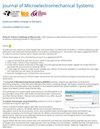Quadruple Mass Gyroscope Angle Random Walk Reduction Through Linearized Transduction
IF 3.1
3区 工程技术
Q2 ENGINEERING, ELECTRICAL & ELECTRONIC
引用次数: 0
Abstract
A quadruple mass Coriolis vibratory gyroscope operating in the mode-matched condition has been redesigned with the singular focus of minimizing nonlinear transduction mechanisms, thereby allowing for angle random walk (ARW) noise reduction when operating at amplitudes higher than通过线性化传导减少四倍质量陀螺仪角度随机漫步
重新设计了在模式匹配条件下工作的四重科里奥利振动陀螺仪,其唯一重点是最大限度地减少非线性传导机制,从而在振幅高于 2~\mu \text{m}$ 时减少角度随机漫步(ARW)噪声。这可以通过以下步骤实现:(i) 重新设计科里奥利质量折叠挠性件和穿梭弹簧,(ii) 在保持寄生模态分离的同时使反相耦合器弹簧率线性化,(iii) 用线性梳状器取代平行板传感器,(iv) 采用专用的力平衡静电频率调谐器,(v) 采用微托真空包装,从而能够在硅的热弹性耗散极限下工作。此外,还通过折曲力矩平衡来降低横轴刚度,从而进一步减少 ARW。通过平衡正负达芬频率贡献,净频率非线性进一步降低到 -20 ppm。本研究中介绍的陀螺仪实现了 0.0005 deg/$\surd $ hr 的 ARW,未补偿偏置不稳定性为 0.08 deg/hr。这些进步有望提高用于导航和测北应用的精密振动陀螺仪的性能。[2023-0144]
本文章由计算机程序翻译,如有差异,请以英文原文为准。
求助全文
约1分钟内获得全文
求助全文
来源期刊

Journal of Microelectromechanical Systems
工程技术-工程:电子与电气
CiteScore
6.20
自引率
7.40%
发文量
115
审稿时长
7.5 months
期刊介绍:
The topics of interest include, but are not limited to: devices ranging in size from microns to millimeters, IC-compatible fabrication techniques, other fabrication techniques, measurement of micro phenomena, theoretical results, new materials and designs, micro actuators, micro robots, micro batteries, bearings, wear, reliability, electrical interconnections, micro telemanipulation, and standards appropriate to MEMS. Application examples and application oriented devices in fluidics, optics, bio-medical engineering, etc., are also of central interest.
 求助内容:
求助内容: 应助结果提醒方式:
应助结果提醒方式:


